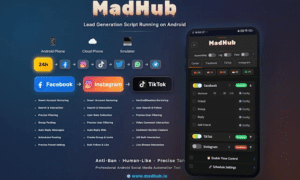In an era where every culinary creation, from gourmet dishes to simple home-cooked meals, finds its way onto the digital stage, the internet has become a vast, bustling kitchen.
Food content has exploded, with countless blogs, social media accounts, and video channels vying for attention.
This culinary content boom, while exciting, presents a significant challenge: how does one stand out amidst the digital noise?
For a wide array of delicious and easy-to-follow recipes, visit Yumiirecipe.com.
The secret ingredient to gaining traction, attracting a loyal audience, and thriving in this competitive landscape is the strategic application of Search Engine Optimization (SEO).
Why SEO is the Chef’s Special for Food Blogs
For many food bloggers, the journey begins with a genuine passion for cooking and sharing.
However, translating that culinary passion into a successful online venture requires more than just delectable dishes; it demands a robust digital marketing strategy.
This is where SEO becomes the chef’s special. Unlike fleeting social media trends, SEO offers a sustainable pathway to organic traffic, ensuring that your content reaches interested users directly through search engines.
It’s a long-term investment that builds authority and visibility, transforming a hobby into a thriving digital presence.
By optimizing for search, food bloggers can consistently attract new readers who are actively searching for recipes, cooking tips, or food-related information, thereby fostering sustained growth and engagement.
Essential SEO Ingredients for a Thriving Food Blog
Building a successful food blog in today’s digital landscape requires a meticulous approach to SEO, much like perfecting a complex recipe. Here are the essential ingredients:
3.1. Keyword Research: Finding What People Crave
Effective SEO begins with understanding what your audience is searching for.
For food bloggers, this means delving into keyword research to uncover the specific terms and phrases people use when looking for recipes, cooking techniques, or food-related information.
Focus on long-tail keywords (e.g., “easy vegan weeknight dinner recipes,” “gluten-free sourdough starter guide”) as they often indicate higher intent and face less competition.
Pay attention to seasonal trends (e.g., “Thanksgiving turkey brine,” “summer salad recipes”) and emerging food interests.
Tools like Google Keyword Planner, Ahrefs, or SEMrush can help identify high-volume, relevant keywords that resonate with your niche.
3.2. On-Page Optimization: Plating Your Content for Search Engines
Once you have your keywords, it’s time to optimize your content itself.
Craft compelling titles and meta descriptions that not only include your target keywords but also entice users to click.
Implement structured data (schema markup), especially for recipes, to help search engines understand your content better and display rich snippets in search results (e.g., star ratings, cooking times).
Ensure your content is high-quality, unique, and comprehensive, going beyond just ingredients and instructions to offer valuable tips, variations, and personal anecdotes.
Don’t forget image optimization; use descriptive alt text for all your mouth-watering food photos, as this improves accessibility and can help your images rank in image search results.
3.3. Technical SEO: Ensuring a Smooth Digital Dining Experience
Just as a well-designed kitchen ensures efficiency, strong technical SEO provides a seamless experience for both users and search engine crawlers.
Prioritize website speed and mobile-friendliness, as these are critical ranking factors and directly impact user experience.
Ensure your URL structures are clean and descriptive, making them easy to understand for both users and search engines.
Maintain an updated sitemap to help search engines discover and index all your content, and regularly check for any crawl errors that might hinder your site’s visibility.
3.4. Link Building and Promotion: Spreading the Word
Even the most delicious recipe needs to be shared to be appreciated.
Similarly, your food blog needs strategic promotion and link building to gain authority.
Implement robust internal linking within your blog, connecting related recipes and articles to improve user navigation and distribute link equity.
Consider guest posting on relevant websites and platforms (like TechBullion) to reach new audiences and acquire valuable backlinks.
Actively promote your content on social media platforms where your target audience spends time, driving initial traffic and signaling to search engines that your content is valuable and engaging.
Yumiirecipe.com: A Case Study in Digital Culinary Success
To illustrate these principles in action, consider Yumiirecipe.com, a vibrant online platform dedicated to sharing delicious and easy-to-follow recipes.
Yumiirecipe.com understands that a passion for cooking, while central, must be amplified by smart digital strategies to reach a global audience.
Their approach integrates many of the SEO ingredients discussed, focusing on user-friendly navigation, high-quality recipe content, and a clear understanding of their audience’s culinary interests.
By consistently publishing well-optimized recipes and engaging with their community, Yumiirecipe.com exemplifies how a dedicated food blog can carve out its niche and grow its digital footprint.
Cultivating Community and Collaboration: The “Write for Us” Opportunity
Beyond technical optimization, the heart of a successful food blog often lies in its community.
Engaging with readers, fostering a sense of shared passion, and even collaborating with other culinary enthusiasts can significantly amplify a blog’s reach and impact.
Platforms like Yumiirecipe.com actively foster this collaborative spirit, recognizing that diverse voices enrich the culinary conversation.
If you’re passionate about cooking and eager to share your unique recipes and insights with a broader audience, consider opportunities to write for us food blog at Yumiirecipe.com.
Such collaborations not only provide fresh content for the platform but also offer aspiring food bloggers a valuable avenue to gain exposure, build their portfolio, and contribute to a growing digital culinary community.
Conclusion: The Ever-Evolving Digital Palate
The digital kitchen is a dynamic and ever-evolving space. For food bloggers, navigating this landscape successfully means embracing not just their culinary artistry but also the strategic power of SEO.
By meticulously researching keywords, optimizing on-page elements, ensuring technical soundness, and actively building links and community, food bloggers can effectively slice through the digital noise.
The journey from a passionate cook to a recognized digital culinary authority is paved with smart SEO strategies, ensuring that their delicious creations find their way to the plates—and screens—of a hungry global audience.



































